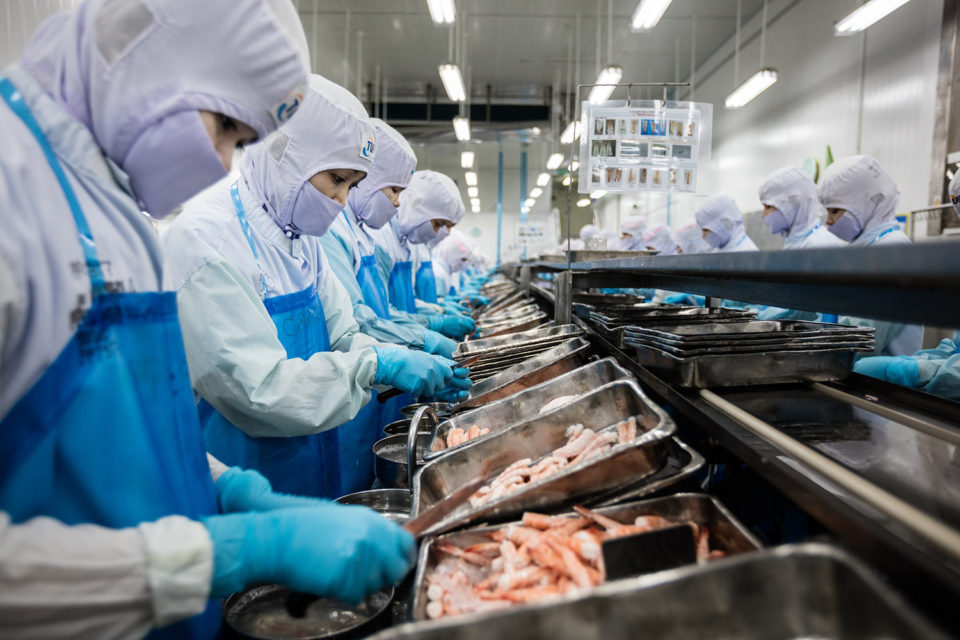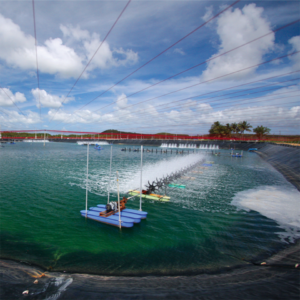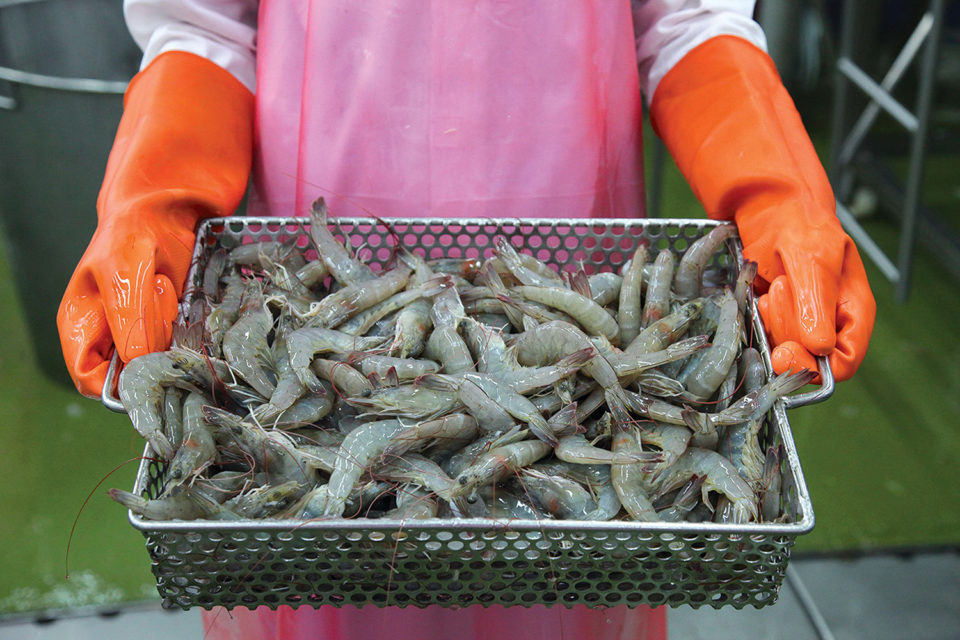Responsibility
Yellow rating from Seafood Watch results from of a decade of work across Thailand’s fishing and aquaculture sectors, which now have even greater aspirations

After an investigation by The Guardian newspaper revealed widespread human rights abuses in the Thai fishing fleet – a major source of fishmeal for the country’s shrimp farmers – the shrimp industry and government leaders worked together to make both industries more equitable and sustainable. Those efforts, along with improvements in water quality management, were key reasons the Monterey Bay Aquarium Seafood Watch awarded Thai shrimp a yellow or “good alternative” rating in July, a step up from the previous red or “avoid” rating.
But while industry leaders celebrated the improvements leading to the change, some felt the new assessment didn’t go far enough in recognizing the extent of the country’s progress.
“Thailand is now not at the bottom,” said Robins McIntosh, executive VP of Charoen Pokphand Foods (CP Foods), one of the world’s largest farmed shrimp producers. “They are a country to look up to as to how you deal with these issues and make things better.”
A focus on water quality
The Seafood Watch report on Thai farmed whiteleg shrimp (Litopenaeus vannamei) was published July 6, 2020, by Seafood Watch. The “good alternative” rating is meant to encourage consumers to “buy, but be aware there are concerns with how they’re caught or farmed.”
Out of 10 criteria, Seafood Watch gave Thai shrimp seven yellow ratings (for data availability, effluent discharge, habitat conservation, chemical discharge, escapes, disease transmission and impact on wildlife), and two green ratings (for using farm-raised, not wild, broodstock and avoiding trans-waterbody transport of live animals). One criterion maintained red: unsustainable feed ingredients. While that may not sound like good news, it’s a step above “critical,” which would have automatically triggered an overall “avoid” rating for Thai shrimp.

In a blog post about the rating, Seafood Watch called the change “a significant development” that resulted from years of work and improvement: “While there’s still a lot to be done, the Thai shrimp farming industry has shown remarkable ingenuity in overcoming disease and economic disaster to build a new system of cleaner, more efficient and more responsible farms.”
Seafood Watch’s previous red or “avoid” rating for Thai farmed shrimp was issued in 2010.
The improvements reflect the efforts of industry, the Royal Thai Government, the Thai Seafood Task Force, and the Best Aquaculture Practices and Aquaculture Stewardship Council certification programs, which recognized the need for an implemented a group certification process, raising the overall standard of the industry, said Dr. Darian McBain, global director of corporate affairs and sustainability for seafood processor Thai Union, a major player in the Thai shrimp industry. “It was definitely a collaborative effort,” she said.
A key factor in the rating change were improvements in water quality management, she noted. The previous Seafood Watch rating had highlighted water quality as an area of concern, noting that most farms frequently released wastewater into the environment. That practice helped fuel major outbreaks of Acute Hepatopancreatic Necrosis Disease (AHPND) in 2012 and 2013, also known as Early Mortality Syndrome, which caused production to drop by 50 percent or more, leading to the near collapse of the industry.
Following the disaster, “there was a much greater emphasis on water quality,” McBain said. Seafood Watch noted that, as farmers rebuilt, they installed storage reservoirs and basins to treat and reuse wastewater. “This led to cleaner water, lower risk of escapes into the wild, and less chance for the spread of disease-causing bacteria,” the organization said.

‘The situation was very difficult indeed’
The 2014 Guardian investigation – as well as subsequent, Pulitzer-prize winning coverage by the Associated Press – also triggered significant changes. “That led everyone, including Thai Union and the other shrimp players in Thailand to look at their shrimp feed supply chain,” McBain said.
“We weren’t directly involved in the fishing industry, but we were indirectly involved in the sense that we were using fishmeal, which was coming from ‘trash fish’ from trawlers and other major sources of fishing in the Gulf of Thailand,” said Bob Miller, who was serving as managing director of CP Foods (UK) at the time. He and other stakeholders formed the Thai Seafood Task Force with a goal of investigating the issue, identifying solutions, and pushing for reform. Other Task Force members include major retailers like Costco, Walmart and Target; suppliers like Bumble Bee Foods and StarKist; and the NGOs like World Wide Fund for Nature and FishWise.
“When we started looking at it, the situation was very difficult indeed,” added Miller, who retired in 2019. The Thai fishing industry had been growing more intensive since the 1960s, but regulations hadn’t kept up, he said. In 2015 and 2016 the Thai government introduced a series of new laws regulating migrant labor, especially in the fishing industries, and updating fishing regulations for the first time since 1946.
Other changes included implementing rigorous fishing vessel monitoring, increasing the mesh size of harvesting nets to allow smaller fish to escape and introducing punishments for violations. The task force worked with the nonprofit Ocean Mind to implement remote monitoring, using satellites and artificial intelligence, to keep fishing vessels out of exclusion zones and protected areas. The monitoring program also enabled the Thai government to prosecute fishing boat owners for fishing violations and abusive labor practices. The government introduced port-in and port-out procedures at its main ports, and fishing vessels faced new limits on the amount of time they could be at sea.
“It was a huge piece of work,” Miller said. “The old system was brought to a halt.” The changes resulted in significant improvements, reducing the trash fish catch significantly, and improving labor conditions and transparency.
After testing new feed ingredients, Thai Union finds reluctant uptake
Shrimp feeds reduce fishmeal inclusion
At the same time, major companies started taking a closer look at the composition of their fish food, and how they could shrink their footprint. CP Foods started using fishmeal made from tuna and tilapia byproduct, reducing the amount of trash fish used. And fishmeal itself was significantly reduced as an ingredient in fish feed, from 25 to 30 percent of the overall formulation to just 10 to 15 percent. Thai Union has replaced fishmeal with ingredients like Calysta’s FeedKind protein, and has looked at other alternative proteins, including insects. The company is now in the process of replacing fish oil with algal oil or other alternatives.
“When the Seafood Watch team came back to rate it again, they found a lot of the Thai producers were using feed that had significantly changed in composition,” McBain noted. As a result, the industry had become much less reliant on the Thai fishing industry for fishmeal.
The work resulted in a “green card” rating from the European Union, after the industry had been hit with a “yellow card” in 2015.
McBain said the new Seafood Watch rating could restore confidence in Thai shrimp as a product, especially among U.S. consumers.
“It’s exciting to see how research and development has led to real outcomes,” McBain said. “But the next challenge will be about how we engage our customers to understand that this shrimp product is more sustainable because the feed is more sustainable. That is the overall sustainability challenge. For most consumers, the feed supply chain is well removed from the product they’re purchasing.”
McBain added that messaging will be a key focus going forward. And while she acknowledged that more improvement is needed, Thai Union would work toward an eventual “green” rating from Seafood Watch.
The next challenge will be about how we engage our customers to understand that this shrimp product is more sustainable because the feed is more sustainable.
“Now that we’ve seen so much improvement, the idea that we could someday get to green seems possible,” McBain said.
Miller, however, took issue with the report’s narrow focus on the fishmeal issue, and felt it failed to take into account the enormous strides that were made in the past decade. He was particularly disappointed by the “red” rating for the fish feed category.
“It’s very difficult to sit here with the knowledge we have of all the work that’s been done, and then to read something like that, which is short of detail, and really is compromising the tremendous work that’s been done by the government, the task force, the industry and expertise from around the world,” Miller said. “It belittles them.”
The rating could discourage other countries from investing in improvements, added McIntosh: “If you do all this good work and you still get a minus, what’s the point?” he said.
The Seafood Task Force continues to work toward improvements, Miller said, adding that next steps will include using the systems and technology now in place to further improve vessel monitoring and best labor and fishing practices.
“I think everybody feels it’s moving in the right direction,” McIntosh said. “It’s much better than it was. It’s a generational problem, and those take time to sort out, but it’s certainly on the mend.”
Follow the Advocate on Twitter @GAA_Advocate
Now that you've finished reading the article...
… we hope you’ll consider supporting our mission to document the evolution of the global aquaculture industry and share our vast network of contributors’ expansive knowledge every week.
By becoming a Global Aquaculture Alliance member, you’re ensuring that all of the pre-competitive work we do through member benefits, resources and events can continue. Individual membership costs just $50 a year. This year, GAA individual and corporate members receive complimentary access to the virtual GOAL conference in October. Join now.
August 31, 2020 at 11:03PM
https://ift.tt/3bdf6wb
Wrestling with a 'generational' problem, Thai shrimp industry rates higher - aquaculturealliance.org
https://ift.tt/3eNRKhS
shrimp

No comments:
Post a Comment